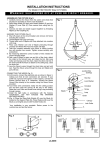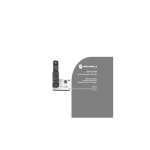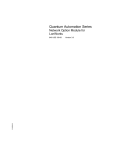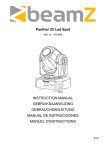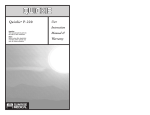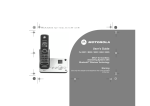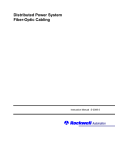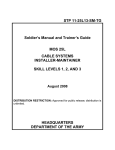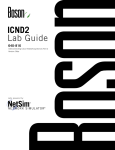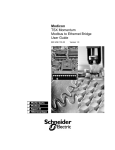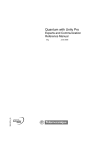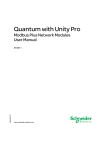Download Modicon Fiber Optic Repeaters User`s Guide
Transcript
Modicon Fiber Optic Repeaters User’s Guide GM–FIBR–OPT Rev. B 1 Contents GM–FIBR–OPT 1.1 Introduction . . . . . . . . . . . . . . . . . . . . . . . . . . . . . . . . . . . . . . . . . . . . . . . . . 2 1.2 Electrical Cable Connections . . . . . . . . . . . . . . . . . . . . . . . . . . . . . . . . . 3 1.3 Fiber Optic Cable Connections . . . . . . . . . . . . . . . . . . . . . . . . . . . . . . . . 3 1.4 Typical Cable System Layouts . . . . . . . . . . . . . . . . . . . . . . . . . . . . . . . . 1.4.1 Point–to–Point Configuration . . . . . . . . . . . . . . . . . . . . . . . . . . . . . . 1.4.2 Bus Configuration . . . . . . . . . . . . . . . . . . . . . . . . . . . . . . . . . . . . . . . 1.4.3 Optical Star Coupler Configuration . . . . . . . . . . . . . . . . . . . . . . . . . 1.4.4 Self–Healing Ring Configuration . . . . . . . . . . . . . . . . . . . . . . . . . . . 4 4 5 6 7 1.5 Selecting Fiber Optic Cable . . . . . . . . . . . . . . . . . . . . . . . . . . . . . . . . . . . 8 1.6 Calculating the Optical Path . . . . . . . . . . . . . . . . . . . . . . . . . . . . . . . . . . 1.6.1 The Optical Power Loss Budget . . . . . . . . . . . . . . . . . . . . . . . . . . . 1.6.1.1 Point-to-Point Example . . . . . . . . . . . . . . . . . . . . . . . 1.6.1.2 Star Coupler Connection Example . . . . . . . . . . . . . . 1.6.1.3 Calculating the Minimum Cable Distance . . . . . . . . . . . . . . . . . . . 1.6.2 Calculating the Number of Chained Repeaters . . . . . . . . . . . . . . 9 9 9 9 10 10 1.7 Recommended Materials . . . . . . . . . . . . . . . . . . . . . . . . . . . . . . . . . . . . . 1.7.1 Connectors . . . . . . . . . . . . . . . . . . . . . . . . . . . . . . . . . . . . . . . . . . . . . 1.7.2 Termination Kits . . . . . . . . . . . . . . . . . . . . . . . . . . . . . . . . . . . . . . . . . 1.7.3 Passive Coupler . . . . . . . . . . . . . . . . . . . . . . . . . . . . . . . . . . . . . . . . . 1.7.4 Tools . . . . . . . . . . . . . . . . . . . . . . . . . . . . . . . . . . . . . . . . . . . . . . . . . . . 1.7.5 Fiber Optic Cables . . . . . . . . . . . . . . . . . . . . . . . . . . . . . . . . . . . . . . . 11 11 11 11 12 12 1.8 Mounting Shelf/Panel Models . . . . . . . . . . . . . . . . . . . . . . . . . . . . . . . . . 13 1.9 Mounting Rack–Mount Models . . . . . . . . . . . . . . . . . . . . . . . . . . . . . . . . 14 1.10 Connecting the Repeater . . . . . . . . . . . . . . . . . . . . . . . . . . . . . . . . . . . . . 1.10.1 Observing Safety Precautions . . . . . . . . . . . . . . . . . . . . . . . . . . . . . 1.10.2 Rear Panel Connectors . . . . . . . . . . . . . . . . . . . . . . . . . . . . . . . . . . 1.10.3 Connecting Power . . . . . . . . . . . . . . . . . . . . . . . . . . . . . . . . . . . . . . . 1.10.4 Connecting the Network Cable . . . . . . . . . . . . . . . . . . . . . . . . . . . . 1.10.5 Setting the Remote I/O Shield–to–Chassis Jumper . . . . . . . . . . 1.10.6 Applying Power . . . . . . . . . . . . . . . . . . . . . . . . . . . . . . . . . . . . . . . . . 15 15 16 17 17 18 18 1.11 Reading the Network Indicators . . . . . . . . . . . . . . . . . . . . . . . . . . . . . . . 19 1.12 Troubleshooting . . . . . . . . . . . . . . . . . . . . . . . . . . . . . . . . . . . . . . . . . . . . . 1.12.1 Troubleshooting Fiber Repeaters for Modbus Plus . . . . . . . . . . . 1.12.2 Testing Connections . . . . . . . . . . . . . . . . . . . . . . . . . . . . . . . . . . . . . 1.12.3 Troubleshooting Fiber Repeaters for Remote I/O . . . . . . . . . . . . 1.12.4 Broken Cable Detection and Remedies . . . . . . . . . . . . . . . . . . . . . 1.12.4.1 Remote I/O Systems . . . . . . . . . . . . . . . . . . . . . . . . . 1.12.4.2 Modbus Plus Networks . . . . . . . . . . . . . . . . . . . . . . . 20 20 22 24 25 25 28 1.13 Specifications . . . . . . . . . . . . . . . . . . . . . . . . . . . . . . . . . . . . . . . . . . . . . . . 30 1.14 Glossary . . . . . . . . . . . . . . . . . . . . . . . . . . . . . . . . . . . . . . . . . . . . . . . . . . . . 32 Contents iii Figures Figure 1 Figure 2 Figure 3 Figure 4 Figure 5 Figure 6 Figure 7 Figure 8 Figure 9 iv Contents Simplified Internal Schematic of Fiber Optic Repeaters . . . . . . Example of Point–to–Point Connection . . . . . . . . . . . . . . . . . . . . Example of Repeaters in a Bus Configuration . . . . . . . . . . . . . . Example of Optical Star Configuration . . . . . . . . . . . . . . . . . . . . . Example of Self–Healing Ring Configuration . . . . . . . . . . . . . . . Mounting Dimensions: Shelf/Panel Models . . . . . . . . . . . . . . . . Mounting Dimensions: Rack Mount Models . . . . . . . . . . . . . . . . Rear Panel Connectors . . . . . . . . . . . . . . . . . . . . . . . . . . . . . . . . . . Indicators Layout . . . . . . . . . . . . . . . . . . . . . . . . . . . . . . . . . . . . . . . 2 4 5 6 7 13 14 16 19 GM–FIBR–OPT Fiber Optic Repeaters User’s Guide Introduction Electrical Cable Connections Fiber Optic Cable Connections Selecting Fiber Optic Cable Calculating the Optical Path Recommended Materials Mounting Methods Installing the Repeater Reading the Network Indicators Troubleshooting Specifications GM–FIBR–OPT Fiber Optic Repeaters User’s Guide 1 1.1 Introduction This manual describes how to install and operate Modicon Fiber Optic Repeaters (Part Numbers 490NRP253, 490NRP254, 490NRP954, NWFR85D200, and NWFR89D200). The repeaters have the following characteristics: Model 490NRP253 provides a Fiber Optic Point-to-Point link between two Modbus Plus connections. The Repeater contains one Fiber Optic Transceiver and one electrical interface for Modbus Plus. Models 490NRP254 and NWFR85D200 provide Fiber Optic Bus and electrical Line-Drop links between Modbus Plus nodes or network segments. Each Repeater contains two Fiber Optic Transceivers and one electrical Modbus Plus interface. Models 490NRP954 and NWFR89D200 provide Fiber Optic Bus and electrical Line-Drop links between Remote I/O nodes or network segments. Each Repeater contains two Fiber Optic Transceivers and one electrical Remote I/O interface. Part Number Network Application Mounting Method Power (Nominal) 490NRP253 Modbus Plus Point-to-Point Panel or Shelf 115/230 Vac, 24 Vdc 490NRP254 Modbus Plus Bus and Line Drop Panel or Shelf 115/230 Vac, 24 Vdc NWFR85D200 Modbus Plus Bus and Line Drop 19 in Rack 125/24 Vdc 490NRP954 Remote I/O Bus and Line Drop Panel or Shelf 115/230 Vac, 24 Vdc NWFR89D200 Remote I/O Bus and Line Drop 19 in Rack 125/24 Vdc Except for their operating power and mounting methods, Modbus Plus repeater models 490NRP254 and NWFR85D200 are identical, and Remote I/O models 490NRP954 and NWFR89D200 are identical. POWER OK POWER SUPPLY ELECTRICAL RX ELECTRICAL TX COMMUNICATION CONTROLLER MBUS+/RIO ELECTRICAL INTERFACE EXTERNAL CONNECTIONS ELECTRICAL PORT FIBER CH1 RX FIBER CH1 TX FIBER OPTIC CHANNEL 1 INTERFACE RX TX FIBER CH1 FIBER CH2 RX FIBER CH2 TX FIBER OPTIC CHANNEL 2 INTERFACE RX TX FIBER CH2 Figure 1 Simplified Internal Schematic of Fiber Optic Repeaters 2 Fiber Optic Repeaters User’s Guide GM–FIBR–OPT 1.2 Electrical Cable Connections Electrical connection to the Modbus Plus network is through the standard Modbus Plus 9–pin “D” connector. Connection to the Remote I/O network is through an “F”–style connector and external Modicon Remote I/O 14 db tap. The electrical port of the Repeater has the same network connections, specifications and restrictions as other Modbus Plus or Remote I/O devices, and must be treated accordingly. Refer to the Modbus Plus System Planning and Installation Guide (GM–MBPL–001), or the 984 Remote I/O Planning Guide (GM–0984–RIO) for information regarding planning your network configuration and the installation of the network electrical cable. 1.3 Fiber Optic Cable Connections The fiber optic cable is connected to the fiber optic ports by a low–loss, industrial ST–type connector. All of the repeaters are passive, meaning there is no regeneration of the received signal in the repeater, and no additional delay to the signal produced by the repeater. Prior to installing the Fiber Optic Repeaters, fiber optic cable must be installed. Follow the cable manufacturer’s recommendations for routing, installation, and testing of the cable. Take care when terminating the ends of each fiber optic cable in order to minimize loss of the optical signal. Follow the manufacturer’s guidelines for installing optical connectors. Test the cable for proper attenuation prior to the connection of the Fiber Optic Repeaters. The cable ends should be accessible at each installation site. Allow sufficient cable length for a service loop and strain reliefs. Label each cable end to facilitate future maintenance. GM–FIBR–OPT Fiber Optic Repeaters User’s Guide 3 1.4 Typical Cable System Layouts This section of your manual describes four typical configurations, and is illustrative of the wide range of Fiber Optic Repeater applications. 1.4.1 Point–to–Point Configuration Figure 2 shows a Point–to–Point connection for two segments of a Modbus Plus network using Fiber Optic Repeaters. The distance between the two Repeaters is limited by the maximum allowable power loss from end to end. Power loss includes the fiber optic cable attenuation, connector losses at the Fiber Optic Receiver and Transmitter ports, and the system margin of 3 dB. Methods of calculating the power loss are explained later in this guidebook. BM85 BRIDGE MULTIPLEXER IBM PC/AT 490NRP253 FIBER OPTIC REPEATER 490NRP253 FIBER OPTIC REPEATER COMPACT 984 (A984–145) with MOTION CONTROL MODBUS PLUS TAPS 984–685E PROGRAMMABLE CONTROLLER = COPPER CORE CABLE = FIBER OPTIC CABLE Figure 2 Example of Point–to–Point Connection 4 Fiber Optic Repeaters User’s Guide GM–FIBR–OPT 1.4.2 Bus Configuration Figure 3 shows the use of Fiber Optic Repeaters in a Bus configuration. This type of configuration permits chaining multiple Repeaters to extend the fiber optic link, thus increasing the distance between the nodes of the network. Such a configuration permits connection of single nodes or clusters of nodes over the fiber optic medium. The calculation of the number of chained Repeaters, and the total distance of this type of fiber optic network, is explained later in this guidebook. PANELMATE PLUS 1000 COMPACT 984 (A984–145) with MOTION CONTROL 984–685E PROGRAMMABLE CONTROLLER IBM PC/AT 984–785E PROGRAMMABLE CONTROLLER MODBUS PLUS TAPS 490NRP253 FIBER OPTIC REPEATER 490NRP254 FIBER OPTIC REPEATER 490NRP254 FIBER OPTIC REPEATER 490NRP253 FIBER OPTIC REPEATER = COPPER CORE CABLE = FIBER OPTIC CABLE Figure 3 Example of Repeaters in a Bus Configuration GM–FIBR–OPT Fiber Optic Repeaters User’s Guide 5 1.4.3 Optical Star Coupler Configuration The use of Optical Star Couplers (active or passive) can provide flexibility in the layout of Modbus Plus and Remote I/O networks. Figure 4 shows one example of an Optical Star Coupler configuration. Additional repeaters can be connected in order to extend communication between electrical links. If a passive Star Coupler is used, the use of 100/140 µm cable is recommended because of its higher available optical power. 984–685E CONTROLLER 490NRP253 FIBER OPTIC REPEATER #5 490NRP253 FIBER OPTIC REPEATER #6 OPTICAL STAR COUPLER IBM PC/AT 490NRP254 FIBER OPTIC REPEATER #4 490NRP254 FIBER OPTIC REPEATER #1 490NRP253 FIBER OPTIC REPEATER #2 IBM PC/AT IBM PC/AT IBM PC/AT 490NRP253 FIBER OPTIC REPEATER #3 16–BUTTON MMI OPERATOR PANEL MODBUS PLUS TAPS Compact–984 with MOT 201 Compact–984 with MOT 202 = COPPER CORE CABLE = FIBER OPTIC CABLE Figure 4 Example of Optical Star Configuration 6 Fiber Optic Repeaters User’s Guide GM–FIBR–OPT 1.4.4 Self–Healing Ring Configuration In some cases, because of the plant layout or network topology, it may be desirable to connect the Modicon fiber optic repeaters in a “self–healing” ring configuration. To support this configuration, the Repeaters have special features built into the signal timing that allow them to be connected in a ring. The advantage of this approach is that if there is a break in the ring, communications will continue on both “legs” of the cable, thus adding a level of reliability to the system. However, it is important to note that there is no sense bit, and detection of a fault is only accomplished through visual inspection of the indicator lights on each Repeater, and by inspecting the physical status of the cable. If fault tolerance with diagnostics is required from the network, the recommended approach is to use dual cable Modbus Plus Communication Adapters such as the AM–S985–800, which do have health and status bits associated with each leg of the cable. Figure 5 shows the “Self–Healing Ring” configuration of Modbus Plus or Remote I/O links connected by Fiber Optic Repeaters over the optical medium. This configuration can be achieved by connecting the second transceiver of the first and last Repeater, in order to close the optical loop. This type of connection has all the advantages of the previously described configurations, along with built–in redundancy. A broken connection between any two Repeaters in the ring will automatically reconfigure the network to continue the communication. The total length of the fiber optic cable in this case can be up to 10 km (32,000 ft), and is essentially limited by the blanking built into the Repeater to prevent the second pass of the data through the optical loop. IBM PC/AT 984–685E CONTROLLER 490NRP254 FIBER OPTIC REPEATER 490NRP254 FIBER OPTIC REPEATER 490NRP254 FIBER OPTIC REPEATER 490NRP254 FIBER OPTIC REPEATER 490NRP254 FIBER OPTIC REPEATER 490NRP254 FIBER OPTIC REPEATER PANELMATE PLUS 1000 IBM PC/AT = COPPER CORE CABLE 984–785E CONTROLLER = FIBER OPTIC CABLE Figure 5 Example of Self–Healing Ring Configuration GM–FIBR–OPT Fiber Optic Repeaters User’s Guide 7 1.5 Selecting Fiber Optic Cable When selecting which type of fiber optic cable to use, several factors must be considered, among them the cable attenuation and the cable bandwidth. Cable attenuation and bandwidth are parameters specified by the cable manufacturers, and depend upon several factors: the wavelength and the spectral width of the optical signal; the cable index (use graded–index only) , and the bandwidth (depends upon the size of the cable [50/125 µm, 62.5/125 µm, and 100/140 µm]). The maximum attenuation for an 820nm optical signal is: 50/125 µm cable 3.5 dB/km 62.5/125 µm cable 3.5 dB/km 100/140 µm cable 5.0 dB/km The bandwidth is the parameter limited by the dispersion of the optical signal along the length of the cable. Two types of dispersion exist: modal dispersion and material dispersion. The modal dispersion widely depends on the fiber core size, numerical aperture (NA), and the difference in the refraction coefficient between core and cladding material of fiber optic cable. This difference in refraction is called the cable index, and results in a pulse spreading because of the different traveling distances for different rays of light entering the multimode fiber. For example, a difference of 1% in refraction coefficient between core and cladding material for step–index fiber produces a pulse spreading (or pulse width distortion) of 50 ns/km. Modal dispersion (and the resultant pulse width distortion) can be reduced by using a smaller core size cable; using a graded–index fiber; and using a fiber with a smaller numerical aperture. Material dispersion results in pulse spreading at the end of the fiber because of the difference in velocities for different wavelengths of the light signal, and depends upon the wavelength and the spectral width of the transmit optical signal. Shown below is the total amount of pulse width distortion (or “jitter”), contributed by fiber optic cable for different cable sizes for 820 nm with +50 nm of spectral width optical signal: 50/125 µm 62.5/125 µm 100/140 µm 3ns/km 5ns/km 7.5ns/km =X where “X’ is the “jitter” in nanoseconds per kilometer Note The value of “X” is used in the formulas on Page 18 when calculating the maximum number of chained repeaters. 8 Fiber Optic Repeaters User’s Guide GM–FIBR–OPT 1.6 Calculating the Optical Path 1.6.1 The Optical Power Loss Budget The maximum length of any optical path between two fiber optic repeaters must be calculated separately, and depends on the total loss in all components used in the path, including fiber optic cable, optical connectors, star couplers, and splices. The sum of the losses in all components used in the optical path must not exceed the specified Power Loss Budget for the chosen cable type. The specified Power Loss Budget includes the loss of the two ST–type connectors which connect at the two repeaters, and also includes the system margin of 3 dB. Thus only other components such as additional connectors, star couplers, and splices, along with cable attenuation, should be taken into account in calculating the loss. 1.6.1.1 1.6.1.2 Point-to-Point Example Point–to–Point connection of 3 km for two repeaters with one splice using 62.5/125 µm optical cable with attenuation of 3.5 dB/km. Power Loss Budget in 62.5/125 µm cable = 11 dB Distance between Repeaters Cable attenuation Splice Loss = = = 3 km 3.5 dB/km .25 dB System loss = 3.5 dB/km x 3 km + .25 dB = 10.75 dB (less than the allowable Loss Budget of 11 dB) Star Coupler Connection Example Total end-to-end connection of 1 km for two repeaters through one star coupler using 100/140 µm optical cable with attenuation of 5 dB/km. Power Loss Budget in 100/140 µm cable GM–FIBR–OPT = 16.5 dB Kaptron 502402–4, 4 x 4, 100/140 µm Star Coupler 2 ST type connectors = Distance between Repeaters = Cable attenuation = 8dB loss 1 dB each 1 km 5 dB/km System loss = 5 dB/km x 1 km + 2 x 1 dB + 8 dB = 15 dB (less than the allowable Loss Budget of 16.5 dB) Fiber Optic Repeaters User’s Guide 9 1.6.2 Calculating the Minimum Cable Distance Because the transmit optical power greatly depends of the fiber size, the calculation of the minimum distance is important to avoid overdriving the Repeater’s optical receiver. When 50/125 or 62.5/125 µm cable is used, there is no limit on the minimum distance required. The minimum distance for other fiber sizes must be calculated. Receiver Sensitivity Repeater Dynamic Range Minimum = Distance = = –30 dBm 20 dB, meaning the maximum received Signal = –10dBm Maximum Optical Power (dBm) – Maximum Received Signal (dBm) Cable attenuation dB/km For example, if 100/140 µm fiber is used, the maximum optical power is – 4 dBm: – 4 dBm – (–10) dBm 5 dB/km = 1.2 km Conclusion: When higher Optical Power is required when using the Optical Couplers or Splitters, then it is permissible to use the larger size fiber. For short distances and minimum distortions, use of the 62.5/125 size fiber is a better solution. 1.6.3 Calculating the Number of Chained Repeaters Because the Repeaters are passive and do not regenerate the received optical data, the number of chained repeaters is limited by the system’s total pulse width (jitter) distortions. The total allowable pulse width and jitter distortion is limited to 20% of the bit period, or: for Modbus Plus for Remote I/O 200 nsec 130 nsec The Jitter contributed by Modicon’s Fiber Optic Repeaters is 10 nsec per box. The Jitter contributed by the Modbus Plus or Remote I/O electrical interface is 40 nsec (receive – transmit). The formula to determine the number (N) of chained Repeaters is: For Modbus Plus N= 200 nsec – X(L)nsec – 40 nsec 10 nsec where “L” is the total cable length (km), and “X” is the jitter in ns/km (see Page 16) For Remote I/O N= 130 nsec – X(L)nsec – 40 nsec 10 nsec where “L” is the total cable length (km), and “X” is the jitter in ns/km (see Page 16) 10 Fiber Optic Repeaters User’s Guide GM–FIBR–OPT 1.7 Recommended Materials Modicon offers these guidelines for selecting optical materials. 1.7.1 Connectors Table 1 Suggested Connectors 1.7.2 Connector Type Part Number Description St Bayonet St Bayonet Push–Pull St ST Bayonet ST Cleave and Crimp Mechanical Line Splice 3M 6105 3M 6100 3M 6102 AMP 501380 Series AMP 504034 Series 3M 2529 Fiberlok II Epoxy, –40 to + 80° C Operational temp Hot Melt, –40 to + 60° C Epoxy, –40 to + 80° C Epoxy, –30 to + 70° C Cleave and Crimp, –40 to + 65° C One size fits all, –40 to + 80° Termination Kits Table 2 Suggested Termination Kits 1.7.3 Kit Type Part Number Description Bayonet or Push–Pull ST Bayonet or Push–Pull ST Bayonet ST Bayonet ST Mechanical Line Splice 3M 8154 3M 6150 AMP 501258–7 AMP 501258–8 3M 2530 Epoxy, 110 or 220 VAC, only for 3M Connectors Hot Melt, 110 or 220 VAC, only 3M Epoxy, 110 VAC, only AMP Connectors EPOXY, 220 VAC, only AMP Fiber Splice Prep Kit, Complete with Cleaving Tool Passive Coupler The AMP Model 95010–4 is a “pig–tail” option, and must be used with an enclosure (use AMP Model 502402–4, a 19” Rack–Mount Enclosure, 1.7 ” high) GM–FIBR–OPT Fiber Optic Repeaters User’s Guide 11 1.7.4 Tools Table 3 Tools Product Part Number Description/Use 3M (Photodyne) Optical Source Driver 9XT 3M (Photodyne) Optical Light Source 1700–0850–T 3M (Photodyne) Power Meter 3M Optical Light Source, 660 nm, visible 17XTA–2041 7XE–0660–J Hand–held optical source driver (requires a light source) 850 nm Light Source, ST Connectors, for 9XT Hand–held Fiber Optic Power Meter Use with 9XT to troubleshoot raw fiber, requires FC/ST patch cord Connects FC connector on 7XE to ST Permits use of above source and meter to test raw fiber (2 required) 3M FC/ST Patch Cord BANAV–FS–0001 3M Bare Fiber Adapter, ST Compatible 8194 1.7.5 Fiber Optic Cables Modicon recommends the use of 62.5/125 graded index, multimode glass fiber for all applications, except where the use of a passive coupler requires use of 100/140 fiber for sufficient launch power to get a satisfactory signal budget. Many cable vendors offer multiple choices for a variety of code ratings. From the variety of cables offered by AMP or Belden, select the one that meets the demands of your application. Wherever possible, Modicon recommends that a multiconductor cable be considered, since it is inexpensive; it provides a backup in case a cable gets cut in the process of pulling it; and you will always find uses for the extra path(s), be it for voice, video, other communications, and/or other control applications. Most 62.5/125 cables are rated at 3.5 dB loss per km. With a multiconductor cable, all the pairs come with an attenuation specification “as measured”. 12 Fiber Optic Repeaters User’s Guide GM–FIBR–OPT 1.8 Mounting Shelf/Panel Models Fiber Optic Repeater models are available for mounting on a horizontal shelf or vertical panel. Your choice of mounting method should provide access to the Repeater for observing its status indicators. You should also locate the unit for easy access to its rear panel connectors, for ease of installation and future servicing. The bottom surface of shelf/panel models is fitted with pads for placement on a horizontal surface, such as a shelf or platform. For vertical mounting, use the brackets supplied with the unit for bolting to a panel. The brackets have tabs that insert into slots on the Repeater’s bottom panel. No additional hardware is required for securing the brackets to the Repeater. You will have to furnish hardware for bolting the Repeater brackets to your panel. Four bolts are required. Typically, standard 1/4–20 (10mm) bolts will be satisfactory. The mounting brackets supplied with the unit for vertical panel mounting can also be used to secure the unit on a horizontal surface. TOP VIEW ALLOW 4.0 IN (100 MM) REAR CLEARANCE FOR ACCESS TO SWITCHES, CABLES, AND FUSE Fiber Optic Repeater 490NRP954 8.3 IN (211 MM) 1.53 IN (39 MM) 5.25 IN (133 MM) 11.5 IN (292 MM) 12.83 IN (326 MM) 14.08 IN (358 MM) REAR PANEL VIEW 2.59 IN (66 MM) Figure 6 Mounting Dimensions: Shelf/Panel Models GM–FIBR–OPT Fiber Optic Repeaters User’s Guide 13 1.9 Mounting Rack–Mount Models Fiber Optic Repeater models are available for installation into a standard 19-inch rack. Your choice of mounting method should provide access to the Repeater for observing its status indicators. You should also locate the unit for easy access to its rear panel connectors, for ease of installation and future servicing. You will have to furnish hardware for bolting the unit into your rack. Four bolts are required. When mounted, the unit can support itself by its front mounting bolts. It is light enough in weight that you do not have to provide rear support within the rack. FRONT PANEL VIEW 3.0 in (76 mm) 3.47 in (88 mm) 18.25 in (464 mm) 19.0 in (483 mm) TOP VIEW ALLOW 4.0 IN (100 MM) REAR CLEARANCE FOR ACCESS TO SWITCHES, CABLES, AND FUSE 17.25 in (438 mm) 9.15 in (232 mm) 8.48 in (215 mm) 10.59 in (269 mm) 1.44 in (37 mm) Figure 7 Mounting Dimensions: Rack Mount Models 14 Fiber Optic Repeaters User’s Guide GM–FIBR–OPT 1.10 Connecting the Repeater 1.10.1 Observing Safety Precautions Before installing the Repeater, read the warning and cautions below. Follow them at all times during the installation of the Repeater. Warning DO NOT view the ends of fiber optic cable under magnification while a transmit signal is present on the cable – SEVERE EYE DAMAGE MAY RESULT. Use white light ONLY! Caution If you are replacing a Repeater on an active Modbus Plus network, the communication between the two links of the network will be temporarily disabled as you replace the unit. Always plan for an orderly shutdown of your control process (if necessary) while you replace a Repeater on an active network. Caution Fiber Optic Repeaters CANNOT be operated with both 115 VAC and 24 VDC power applied at the same time (i.e., as with UPS backup), or with both 125 VDC and 24 VDC applied at the same time. Caution When DC power is used, the POWER switch on the unit is disabled. Power is supplied to the unit when source power is activated. Under DC power, the unit does not provide surge protection. Caution Do not remove the fiber optic connector covers until the fiber cable is about to be connected. Also, if any optical connector will remain unused, do not remove the connector covers from the unused connector. After connecting the fiber cable, retain the dust covers for future use. GM–FIBR–OPT Fiber Optic Repeaters User’s Guide 15 1.10.2 Rear Panel Connectors AC/DC MODELS 24 VDC CONNECTOR CHASSIS GROUND SCREW JP1 FIBER PORT 1 Tx Rx FIBER PORT 2 Tx Rx 1 2 + – POWER SELECTOR PLUG AND FUSE POWER SWITCH POWER CABLE CONNECTOR REMOTE I/O SHIELD–TO–CHASSIS JUMPER (RIO MODELS ONLY) MODBUS PLUS CABLE CONNECTOR REMOTE I/O CABLE CONNECTOR (RIO MODELS ONLY) (MODBUS PLUS MODELS ONLY) DC/DC MODELS GROUND FIBER PORT 1 JP1 Tx Rx FIBER PORT 2 Tx Rx 1 2 + – 125 VDC + – 24 VDC REMOTE I/O SHIELD–TO–CHASSIS JUMPER (RIO MODELS ONLY) REMOTE I/O CABLE CONNECTOR (RIO MODELS ONLY) MODBUS PLUS CABLE CONNECTOR (MODBUS PLUS MODELS ONLY) Figure 8 Rear Panel Connectors 16 Fiber Optic Repeaters User’s Guide GM–FIBR–OPT 1.10.3 Connecting Power Grounding: The Repeater obtains its ground through the chassis ground screw or DC ( – ) wire. Connect the Repeater to the site ground. After making and securing this connection, use a continuity tester to verify the Repeater chassis is grounded to the site ground. Connecting AC Power: Before connecting power, remove the power at its source. The AC power cable supplied with the Repeater is keyed for North American 110–120 VAC power outlets. If necessary, install a different plug on the cable for the power source at your site. Remove the AC power cable from the Repeater. Set the power selector plug to the 110–120 VAC or 220–240 VAC position for the power source at your site. To do this, remove the power selector plug by prying under its tab using a small screwdriver. Set the plug to the proper voltage position as shown on the plug body, then reinsert it. Insert the power cable into the rear panel connector. Plug the cable into the AC power source. Connecting DC Power: Before connecting power, remove the power at its source. Connect the source to the DC power terminals, observing the proper polarity. 1.10.4 Connecting the Network Cable The electrical cable should already be run to the Repeater site, with a connector installed. If the cable and connector are not in place, refer to the Modbus Plus System Planning and Installation Guide (GM–MBPL–001), or the 984 Remote I/O Planning Guide (GM–0984–RIO), for information regarding planning your network configuration and the installation of the network electrical cable. The fiber optic cables should already be run to the site, with connectors installed. If they are not in place, install them using the guidelines given earlier in this guide. Each cable should be labeled to identify the transmit/receive link to which it connects. Refer to Figure 8. Connect the Modbus Plus or Remote I/O electrical cable and the fiber optic cables to the Repeater’s rear panel connectors. Secure the electrical cable connector by tightening its two screws. GM–FIBR–OPT Fiber Optic Repeaters User’s Guide 17 1.10.5 Setting the Remote I/O Shield–to–Chassis Jumper The RIO cable shield–to–chassis jumper (on the rear of the unit) is shipped in the neutral position (midway between “1” and “2” pins.) Set the jumper to the position that will be used in your application. When the jumper is in the “2” position, the RIO cable shield is connected directly to chassis ground. When the jumper is in the “1” position, the RIO cable shield is isolated from chassis ground by a capacitor. 1.10.6 Applying Power Before applying power, verify that all power connections, electrical cable connections, and fiber optic connections are correctly installed for your application. Applying AC Power: If you are using AC line power, apply AC to the Repeater site. The Repeater’s main power switch controls the power to the unit. Set the power switch to the “1” position (ON). The unit’s POWER OK indicator will illuminate. Applying DC Power: If you are using DC power, switch on your DC to the Repeater. The unit’s POWER OK indicator will illuminate. 18 Fiber Optic Repeaters User’s Guide GM–FIBR–OPT 1.11 Reading the Network Indicators The layout of the Repeater’s indicators is shown in Figure 9. Refer to the illustration applicable to your unit. 490 NRP 253 power OK fiber port power OK fiber port 1 modbus plus 490 NRP 254 fiber port 2 modbus plus FR85D200 modbus plus fiber port 2 fiber port 1 power OK 490 NRP 954 power OK fiber port 1 fiber port 2 remote I/O FR89D200 remote I/O fiber port 2 fiber port 1 power OK Figure 9 Indicators Layout The POWER OK indicator illuminates steadily when the Repeater has normal power from the AC line or DC source and its internal power supply is operating normally. The MODBUS PLUS or REMOTE I/O port indicator lights when a signal is received at the Repeater’s electrical port. Each FIBER port indicator lights when a signal is received at the fiber RX port. If a port indicator fails to illuminate, it can indicate a lack of transmitted signal at another network node. Before replacing the Repeater, check the cable connections on the rear panel for a possible incorrect or loose connection. Also check the indicators on other devices on the signal path to see if the signal loss is external to the Repeater. GM–FIBR–OPT Fiber Optic Repeaters User’s Guide 19 1.12 Troubleshooting 1.12.1 Troubleshooting Fiber Repeaters for Modbus Plus The indicator lights on Modicon’s Modbus Plus Fiber Optic Repeaters can be used to debug and troubleshoot an application. In fact, when the function of the indicators is understood, an installer can usually successfully bring on line good equipment, and isolate fault down to the replaceable element of a system having faulty components. This requires only a knowledge of the indicators’ operation and the use of known good components. This section explains how the indicators work, and how such knowledge can be used by an installer to bring up a system; or in case of fault, how to troubleshoot down to the replaceable component. An example of indicators on a Modbus Plus Repeater is shown below: power OK fiber port modbus plus Power Fiber port 1 = ON, steady green, when power is applied. = ON, steady amber, when the fiber receiver is receiving packets from another fiber optic repeater. Modbus Plus = ON, steady amber, when the repeater is receiving packets from devices on the wireside Modbus Plus network. The Modbus Plus indicator is also activated by receive signals, illustrated conceptually as: RX Optical Signal TX Fiber Port MB+ Modbus Plus Packet 20 Fiber Optic Repeaters User’s Guide GM–FIBR–OPT The following example makes use of this information in bringing up two point–to–point fiber optic repeaters. Connect the repeaters as shown: 490NRP253 FIBER OPTIC REPEATER FR1 TX RX RX TX 490NRP253 FIBER OPTIC REPEATER FR2 POWER POWER NOTE: Connect Transmitter to Receiver and Receiver to Transmitter. Duplex cables have markings on one of the two jackets to aid in identification. Apply power and observe: 490NRP253 FIBER OPTIC REPEATER FR1 Pwr FP TX RX RX TX MB+ 490NRP253 FIBER OPTIC REPEATER FR2 Pwr FP MB+ Both power lights should illuminate; no other lights should come on. Now connect a single Modbus Plus Node to one of the repeaters: MODBUS PLUS NODE #1 490NRP253 FIBER OPTIC REPEATER FR1 TX RX Pwr FP MB+ RX 490NRP253 FIBER OPTIC REPEATER FR2 TX Pwr FP MB+ The Modbus Plus Node generates packets, regardless of whether an application is present; therefore, the Modbus Plus receiver is getting data, and its indicator is blinking. The transmitter of FR1 passes the packets to the receiver of FR2, and its fiber port indicator will blink. Note The Repeater’s blinking pattern does not follow the standard Modbus Plus network indicator flashing pattern of other Modbus Plus devices. GM–FIBR–OPT Fiber Optic Repeaters User’s Guide 21 To verify proper operation of the rest of the system, relocate Modbus Plus Node 1 so it is attached to FR2, as shown below. If the system is configured correctly, the indicators should illuminate as follows: Repeater FR1 FR2 490NRP253 FIBER OPTIC REPEATER FR1 Pwr FP Indicator Fiber Port BLINKING OFF TX RX RX TX MB+ 1.12.2 Modbus Plus OFF BLINKING 490NRP253 FIBER OPTIC REPEATER FR2 Pwr FP MODBUS PLUS NODE #1 MB+ Testing Connections Most failures in any kind of network are in the “medium”; that is, the wire, the fiber, and their connections. Therefore, if any of the above configurations fail to give the expected state of the indicators, your first suspicion should be that the cable, fiber, or their terminations are at fault. Test #1 In the above example, with Node 1 alone attached to FR1, if the Modbus Plus light on FR1 does not blink, check for continuity of the Modbus Plus cable, pin–to–pin. If this is correct, try attaching Node 1 to FR2. If the Modbus Plus indicator on FR2 begins to blink, then Node 1 must be transmitting, FR2 is receiving, and FR1 has failed and needs replacement. If Node 1 attached to FR2 fails to cause the Modbus Plus indicator to blink, Node 1 must be presumed to have failed. Test #2 Assuming Node 1 attached to FR1 succeeds in illuminating the Modbus Plus indicator, the FP indicator of FR2 should blink. If it does not, reverse the fiber connections at either one or another (but not both) of the fiber repeaters. [The correct connection is Transmitter to Receiver, Receiver to Transmitter.] If the fiber port indicator of FR2 still fails to blink, reattach Node 1 to FR2. Test #3 After Node 1 is reattached to FR2, the Modbus Plus indicator of FR2 and the FP indicator on FR1 should both be on. If this test succeeds, you have probably isolated the failure to the optical fiber now connected to the receiver of FR2, the transmitter of FR1. To confirm this suspicion, reverse the fiber connections to both FRs. If, as suspected, one fiber repeater is “bad”, Node 1 attached to FR2 will no longer communicate to FR1. If Node 1 is reattached to FR1, then the signal will transmit to FR2. Having isolated the fault to the fiber, you will have to use other tools, such as a light source and power meter, to verify discontinuity, and then confirm continuity after correction of the fault. 22 Fiber Optic Repeaters User’s Guide GM–FIBR–OPT Using the tests just described, most of the time you will be able to find the fault/failure in a “broken” system without use of elaborate test equipment. Necessary components (pre–tested for reliability) for such troubleshooting are: a Modbus Plus node (It can – but need not – be running an application. All it must do is pass tokens to be usable.) a length of Modbus Plus cable, properly terminated Fiber Optic Repeater a fiber “pigtail” knowledge and implementation of the above procedures. The previous descriptions use the 490 NRP 253 Repeater, which has a single fiber port. You can use a two–port Repeater in the same place as a single–port unit, but the reverse is not true. When a two–port unit is used as a point–to–point device, one fiber port is simply not connected. GM–FIBR–OPT Fiber Optic Repeaters User’s Guide 23 1.12.3 Troubleshooting Fiber Repeaters for Remote I/O Examine this conceptual diagram of a typical Remote I/O Fiber Optic application: MASTER NODE PLC S 9 0 8 14 dB Tap To Other Drops or Repeaters Coaxial Cable Coax May or May Not be Connected to Other Drops or Repeaters TX FP2 490 NRP 954 FR1 Fiber FP1 RX RX FP1 Fiber To Other Drops or Repeaters 490 NRP 954 FR2 TX FP2 May or May Not be Connected to Other Drops or Repeaters 14 dB Tap DROP J 8 9 0 There are well documented procedures for analyzing the wireside characteristics of this type application, and it is recommended they be used as a first line of attack and afterward whenever trouble is suspected. If the S908 is working properly, it should cause the Remote I/O indicator for FR1 to blink. If that indicator blinks as expected, then the fiber port indicator (FP1) for FR2 should blink, and the other (FP2) should be OFF. If the FP1 indicator does not blink, check for proper connection (Transmit to Receive, Receive to Transmit). If no results are obtained, substitute a known good FR for the one at FR2 and proceed from the beginning. If this fails, the fault has been isolated to faulty fiber, and fiber testing procedures must be used. 24 Fiber Optic Repeaters User’s Guide GM–FIBR–OPT 1.12.4 Broken Cable Detection and Remedies 1.12.4.1 Remote I/O Systems Unlike S908 coaxial cable, fiber optic cable contains physically separate transmit and receive lines. It is possible to lose communications through the receive line while the transmit line remains intact, as depicted here: PLC S908 RI/O COAXIAL CABLE TO DROP 2 490 NRP 954 S908 BRIDGE RX TX FIBER OPTIC CABLE BROKEN OR DISCONNECTED RECEIVE LINE RX TX 490 NRP 954 S908 BRIDGE S908 RI/O COAXIAL CABLE TO DROP 2 S908 RI/O HEAD B805 16 IN B804 16 OUT A break in the receive line as shown above will deprive the PLC of input data. Under ordinary circumstances, the PLC will continue to drive outputs via the intact transmit line. This could lead to outputs turning ON or OFF due to invalid (INPUT STATE: 0) input data. A method to prevent this from happening is to use STAT and SENS function blocks in the PLC’s ladder logic to detect the loss of input communication. This logic can inhibit outputs from improper state changes. Here is an example: GM–FIBR–OPT Fiber Optic Repeaters User’s Guide 25 Seg. 1 #1 / 1 40101 STAT #0187 #0001 ( ) 40285 00097 SENS #0001 ( ) 00097 00001 ( ) 00097 00002 The STAT and SENS blocks monitor the I/O status of Drop #2 and inhibit outputs 00001 and 00002 if communications are lost. The STAT block provides access to the system’s status, including the status of S908 communications. The status information is stored in a table which starts at 40101 and has a length of 187 words (as shown in the top and bottom nodes of the STAT block). The SENS block has been programmed to sense the first, or “Communications Health,” bit (SENS top node value = 1) of the 185th word in the status table (SENS middle node value = 40285). This bit is the communications health for Drop 2 of the S908. Coils 00001 and 00002 in the example have been configured as outputs in the I/O Map, as shown below. 26 Fiber Optic Repeaters User’s Guide GM–FIBR–OPT Utility DelDrop HoldTme ASCPort GetDrop Quit F1––––––F2––––––F3––––––F4–––––––F5––––––F6–––––––F7–Lev8–F8–OFF–––F9 I/O MAP 800 SERIES I/O Drop : 2 of 32 Rack : 1 Drop Hold Up Time: 3 (x100ms) ASCII Port : 0 Number Inputs: 16 Number Outputs : 16 ___________________________________________________________________________________ Slot Module Type 101 102 103 104 105 106 107 108 109 110 111 984 984 B805 B804 B8 B8 B8 B8 B8 B8 B8 Reference Numbers Input Output 10001 –10016 00001 –00016 Data Type Module Description PLC–685E PLC–685E 16–IN B805 16–OUT B804 When the PLC’s Rx line is broken as depicted, the SENS’ed bit becomes 0 (OFF). The middle node output to coil 00097 is set to 0 (OFF). Coil 00097 controls normally open relays which, when power is removed, opens the circuits to coil 00001 and coil 00002, thus inhibiting these outputs. As an alternative, the logic could control a SKP block to prevent execution of that portion of the network which would ordinarily output data through coils 00001 and 00002. Refer to the Modicon 984 Programmable Controller Systems Manual (GM–0984–SYS) for further information about using STAT and SENS and SKP blocks for this application. Be sure to test your logic for correct performance. GM–FIBR–OPT Fiber Optic Repeaters User’s Guide 27 1.12.4.2 Modbus Plus Networks Due to the nature of fiber optic cable, it is possible to break or disconnect the TX line independent of the RX line. The effect of this on a Modbus Plus network is shown in the following example: PC 3 (Running MBPSTAT) SEE NETWORK STATUS DISPLAY “A” PLC 1 PLC 2 MODBUS PLUS CABLE 490 NRP 253 MODBUS PLUS PT–to–PT TX RX RX TX FIBER OPTIC CABLE WITH BROKEN OR DISCONNECTED TRANSMIT LINE 490 NRP 253 MODBUS PLUS PT–to–PT MODBUS PLUS CABLE PLC 4 PLC 5 PC 6 (Running MBPSTAT) SEE NETWORK STATUS DISPLAY “B” Note that the sample network consists of six nodes, three on either side of each Fiber Optic Repeater. A broken Tx line from the standpoint of nodes 1, 2, and 3 will cause the Modbus Plus network indicator LED’s on every node to illuminate. This “disconnect code” consists of 2 flashes, followed by a 2–second pause. The two PLC’s and the PC will cease data communications. The MBPSTAT program, running on the PC at node 3, displays all six nodes of the network, but no communication activity. 28 Fiber Optic Repeaters User’s Guide GM–FIBR–OPT MODBUS PLUS NETWORK STATUS version 2.30 Global Data Activity, strike any key to exit 01 02 03 04 05 Adapter: 0 Success: 0 Failure: 0 06 DISPLAY “A” On the other side of the break, nodes 4, 5, and 6 “re–form” into a smaller Modbus Plus network. The Modbus Plus status LED’s at each node blink rapidly, indicating normal communication among these three nodes. Note that MBPSTAT, running on the PC at Node 6, displays only the three nodes of the re–formed network. MODBUS PLUS NETWORK STATUS version 2.30 Global Data Activity, strike any key to exit Adapter: 0 Success: 103 Failure: 0 04 05 06 00 00 00 DISPLAY “B” GM–FIBR–OPT Fiber Optic Repeaters User’s Guide 29 1.13 Specifications Product Identification The following table summarizes Fiber Optic Repeater part numbers and applications: Part Number Network Application Mounting Method Power (Nominal) 490NRP253 Modbus Plus Point-to-Point Panel or Shelf 115/230 Vac, 24 Vdc 490NRP254 Modbus Plus Bus and Line Drop Panel or Shelf 115/230 Vac, 24 Vdc NWFR85D200 Modbus Plus Bus and Line Drop 19 in Rack 125/24 Vdc 490NRP954 Remote I/O Bus and Line Drop Panel or Shelf 115/230 Vac, 24 Vdc NWFR89D200 Remote I/O Bus and Line Drop 19 in Rack 125/24 Vdc Except for their operating power and mounting methods, Modbus Plus repeater models 490NRP254 and NWFR85D200 are identical, and Remote I/O models 490NRP954 and NWFR89D200 are identical. System Specifications Data Rate, Modbus Plus 1 Mbit/sec for Modbus Plus with Bi–Phase S encoded data Data Rate, Remote I/O 1.544 Mbit/sec for Remote I/O with Manchester encoded data Electrical Interface Modbus Plus connection via 9–pin “D” connector Remote I/O via “F” Connector Optical Interface ST–type Connectors Pulse Width Distortion/Jitter < 10 nsec Bit Error Rate 10–9 over specified Optical Receiver Dynamic Range Wavelength 820 nm Power Loss Budget (includes 3dB of system Margin) 50/125 µm fiber – 7.0 dB 62.5/125 µm fiber – 11 dB 100/140 µm fiber – 16.5 dB Maximum Distance for point–to–point connection 2km over 50 µm fiber @ 3.5 dB/km 3km over 62.5 µm fiber @ 3.5 dB/km 3km over 100 µm fiber @ 5 dB/km Reliability Service Life 5 years MTBF 50,000 hours (minimum) @ 30° C, assuming fixed ground and component stress within maximum specifications 30 Fiber Optic Repeaters User’s Guide GM–FIBR–OPT Power Requirements (AC/DC Models) AC Input DC Input 90–130 VAC 180–264 VAC 19.2–30 VDC AC Internal Fuse Rating 120 mA 60 mA 300 mA 1 A @ 110 V .5 A @ 220 V Power Requirements (DC/DC Models) DC Input 105–140 VDC 19.2–30 VDC 41 mA @ 125 VDC 300 mA Retention on Power Loss Remains in regulation > 10 ms after removal of power Inrush Current 6 A typical @ 125 VDC Ground Leakage 1 mA @ 140 VDC Optical Transmitter Specification Optical Power – 13.0 – 20.0dBm average power (Measured with 1m Test fiber) in 50/125 µm Fiber cable –10.0 – 16dBm average power in 62.5/125 µm Fiber cable – 4.0 – 10.5dBm average power in 100/140 µm Fiber cable Rise/Fall Time Silence or “OFF Leakage” 20 nsec or better – 43 dBm Optical Receiver Specification Receiver Sensitivity Dynamic Range Directed Silence – 30dB/m average power 20 dB – 36 dB Environmental Specification Operating Temperature Storage Temperature Humidity 0 to 60° C – 40 to + 85° C 10% – 95% non–condensing Radiated Susceptibility 27 ... 500 mHz, 10 V/m (IEC 801-3, level 3) Surge Withstand, Fast Transient 2 kV, 1 kV on I/O (IEC 801-4, level 3) Surge Withstand, Oscillatory Wave 2.5 kV (IEEE 472). (Surge Withstand tests into 50 ohms using V-3300 Generator, corresponds to levels twice as high into open circuit) GM–FIBR–OPT Surge Transients 2 kV (IEC 801-5, level 3) Electrostatic Discharge 8 kV, ten discharges (IEC 801-2, level 3) Fiber Optic Repeaters User’s Guide 31 1.14 Glossary attenuation The decrease in magnitude of power of a signal in transmission between points. A term used for expressing the total losses on an optical fiber consisting of the ratio of light output to light input. Attenuation is usually measured in decibels per kilometer (dB/km) at a specific wavelength. The lower the number, the better the fiber. Typical multimode wavelengths are 850 and 1300 nanometers (nm); single mode, at 1300 and 1550 nm. NOTE: When specifying attenuation, it is important to note if it is nominal or average, room temperature, value or maximum over operating range. bandwidth A measure of the information–carrying capacity of an optical fiber, normalized to a unit of mHz/km. Fiber bandwidth depends on the length of the fiber, and is usually expressed in mHz/km, even though the length dependence is not linear for multimode fibers. bit period The time required to define a data bit at a particular bit rate. [For Modbus Plus, 1 mBit results in 1/Bit Rate = 1/1 x 106 = 10–6 = 1 msec. For Remote I/O, 1/1.544 x 106 = .648 µsec = 648 nsec.] cladding The material surrounding the core of an optical waveguide. The cladding must have a lower index of refraction in order to steer the light in the core. connector A mechanical device used to align and join two fibers together to provide a means for attaching and decoupling it to a transmitter, receiver or another fiber. Commonly used connectors include the FC, FCPC, Biconic, ST Connector–Compatible, D4, SMA 905 or 906. core The central region of an optical fiber through which light is transmitted. decibel (abbr. dB) Unit for measuring the relative strength of a signal. digital A data format that uses two physical levels to transmit information. A discrete or discontinuous signal. dispersion The cause of bandwidth limitations in a fiber. Dispersion causes a broadening of input pulses along the length of the fiber. Three major types are: (a) mode dispersion caused by differential optical path lengths in a multimode fiber; (b) material dispersion caused by a differential delay of various wavelengths of lights in a waveguide material; and (c) waveguide dispersion caused by light traveling in both the core and cladding materials in single mode fibers. fiber A thin filament of glass. An optical waveguide consisting of a core and a cladding which is capable of carrying information in the form of light. fiber optics Light transmission through optical fibers for communication or signalling. graded–index Fiber design in which the refractive index of the core is lower toward the outside of the fiber core and increases toward the center of the core; thus, it bends the rays inward and allows them to travel faster in the lower index of refraction region. This type of fiber provides high bandwidth capabilities. link A fiber optic cable with connector attached to a transmitter (source) and receiver (detector). local area network (abbr. LAN) A geographically limited communications network intended for the local transport of data, video and voice. 32 Fiber Optic Repeaters User’s Guide GM–FIBR–OPT mechanical splicing Joining two fibers together by mechanical means to enable a continuous signal. Elastometric splicing is one example of mechanical splicing. megahertz (abbr. MHz) A unit of frequency that is equal to one million hertz. micron (abbr. µm) Another term for micrometer. One millionth of a meter. 10exp–9meter. mode A term used to describe a light path through a fiber, as in multimode or single mode. modulation Coding of information onto the carrier frequency. This includes amplitude, frequency, or phase modulation techniques. multimode fiber An optical waveguide in which light travels in multiple modes. Typical core/cladding sizes (measured in microns) are 50/125, 62.5/125, and 100/140. nanometer (abbr. nm) A unit of measurement equal to one billionth of a meter. 10exp–9 meters. numerical aperture The number that expresses the light gathering power of a fiber. point–to–point A connection established between two specific locations, as between two buildings. repeater A device which consists of a transmitter and receiver or transceiver, used to amplify a signal to increase the system length. receiver An electronic package which converts optical signals to electrical signals. scattering A property of glass which causes light to deflect from the fiber and contributes to losses. source The means used to convert an electrical information–carrying signal to a corresponding optical signal for transmission by fiber. the source is usually a Light Emitting Diode (LED) or Laser. splicing The permanent joining of fiber ends to identical or similar fibers, without the use of a connector. See also fusion splicing and mechanical splicing. star coupler Optical component which allows emulation of a bus topology in fiber optic systems. step–index fiber Optical fiber which has an abrupt (“step”) change in its reflective index, due to a core and cladding that have different indices or refraction. Typically used for single mode. transmitter An electronic package which converts an electrical signal to an optical signal. wavelength The distance between the same point on adjacent waves. GM–FIBR–OPT Fiber Optic Repeaters User’s Guide 33




































